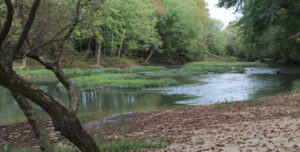Every body of water has what’s known as a watershed. A watershed is simply the land that water flows across or through on its way to a common stream, river, or lake. As rainwater or melted snow runs downhill into the watershed, it collects and transports sediment and other materials and deposits them into the receiving waterbody. Our Earth is covered in 70% water; unfortunately, 40-50% of our nation’s waters are impaired or threatened. It is important to know that with every action taken around any body of water there is the potential to have negative effects downstream. We all live downstream; by effectively managing our watershed activities we can reduce the risk of harm to the environment and water that we all share.
Public drinking water in the United States is considered among the safest in the world; however, its safety cannot be taken for granted. The increasing use of chemicals in the American landscape and aging infrastructure produces new threats to our water supply. The most common drinking water contaminants detected in Kentucky are:
Bacteria (an indication that water may be contaminated with fecal matter)
Turbidity or cloudiness (which can interfere with the treatment process and allow pathogens to survive)
Trihalomethanes (organic chemicals created during the disinfection of water)
Inorganics (includes nitrates and metals such as mercury and barium)
The purpose of managing a watershed is to minimize the impact of land uses that threaten the quality and quantity of the public drinking water supply. The underlying theme is simply to prevent pollution. Preventing pollution is the key to keeping groundwater supplies safe to protect the public and environmental health.

How to Keep Your Watershed Clean and Healthy
There are many ways to keep our watersheds clean, below are just a few ways that everyone can help to accomplish this very important goal.
- Be very cautious on how you dispose of toxic chemicals and pharmaceuticals, never pour them down the drain and always take them to a hazardous waste center for disposal.
- Never litter, most importantly by dumping into streams or lakes or even down storm drains
- Keep your septic tank maintained, septic tanks can leak waste into the soils and eventually make its way into an aquifer.
- Never pour used oil or antifreeze into the storm drain, street or onto the ground
- Make it a priority to protect our watersheds from harmful substances such as chemicals, also soil and animal waste.
- Consider constructing riparian zones if your property is located near a body of water. Riparian zones are a natural vegetative buffer between land and water. They protect the water they border by reducing erosion, providing flood control, and filtering sediments and pollutants before they can enter the body of water.
Nothing is more important to sustaining life than protecting our waterways. If we all work together, we can keep our watershed clean and sustained for years to come!
Knowing the importance of protecting our water sources from contamination, Hardin County Water District No. 2 has developed and filed with the Kentucky Division of Water Spring Basin-Watershed Protection and Wellhead Protection Plans for our area. These plans give great detail on protecting our local water sources, please click here to view our Wellhead Protection Plan for White Mills. If you are interested in learning about the Wellhead Protection Plan in Elizabethtown, please click here.

